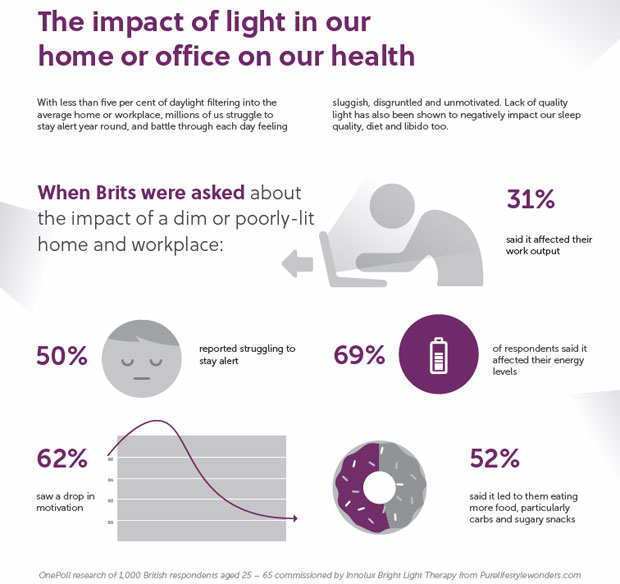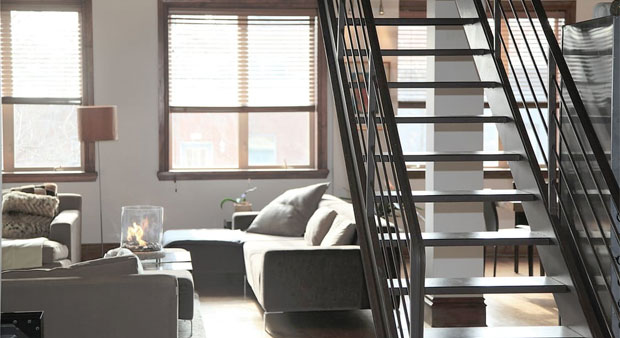What Your Doctor Ordered – Light Therapy in The Home

What Your Doctor Ordered – Light Therapy in The Home
Light influences how we feel, how productive we are and even to an extent what we eat. However most of us are severely ‘light deprived’ because levels of brightness in our homes aren’t high enough to help regulate our body clock. In fact, less than five per cent of daylight filters into the average home.
The normal indoor lighting in a well enlighten home is as little as 100 lux – this is a thousand times less than the volume of natural light outside on an average summer day. Not surprisingly, in the latest research by Innolux Bright Light Therapy found Britons are battling through the day because of a lack of natural light. Of the 1,000 Brits surveyed, the majority said lack of good quality light can have an impact on their energy levels and mood (69% and 64% respectively). And 65% claim the main reason that they are dissatisfied with the lighting levels in their homes is that is it too dark.
However, technology has caught up. Innolux, a Finnish design lighting brand specialises in creating light that mimics natural sunlight (without UV damage) and has just launched into the interior world in the UK.
Its devices don’t look like the traditional clunky light boxes or sad lamps but are stylishly designed to be naturally incorporated into your home to give you all year round bright light therapy benefits.
So what can we do to help ensure your home is a healthy living space?
Here are three top tips:

- Increase the amount of natural light at home
The first thing to consider is to make sure you maximize the light from existing windows. Pull curtains back and shades up during the day. Do not block window light with furniture either in front of the window or close to the sides of the window. Especially avoid thick, dark furniture next to a window. If necessary, consider installing a new or expanded window or installing a skylight.
It is also worth considering whether you can update your front door to let more sunlight in, such as change a solid exterior door for one with windows. Sliding glass doors are a wonderful way to open up a room with light if you have a nice view (yard, scenery, deck or patio) to look out on.
Last but not least, think about your home décor – use white or light colors throughout the room to reflect natural light that comes in, white painted trim around the window helps too. Consider mirrors across from a window will reflect the light into different parts of the room.
- Use bright light therapy
Bright light devices work by delivering daylight or light of specific wavelengths to the back of the eye (retina) to help keep the circadian and other rhythms relating to the body clock stable. They are most effective between 6am and 10am – when we are naturally supposed to be exposed to daylight.
With certain light devices, such as Innolux, there’s no need to look at the light directly. This means you can carry on with your everyday activities such as reading, eating, working or watching TV while taking advantage of bright light therapy.
Research shows that bright light therapy improves overall wellbeing, regardless of whether you suffer from seasonal affective disorder. It can therefore help anyone to support their wellbeing year round. Improvements were found in 10 days and lasted a month after stopping therapy.
It is worth checking the Innolux range, a Finnish brand that has just launched in the UK. Its devices don’t look like the traditional clunky light boxes or sad lamps but stylishly designed to be naturally incorporated into your home to give you year round benefits. Availble in the UK from www.purelifestylewonders.com from £89. 
- Plan your lighting design scheme carefully
The light fitting, apart from its primary task, has also an important role in home decoration. It’s actually the light that shows off a space to its best advantage. A well-designed lighting scheme will make your home feel spacious, welcoming and will help you to create the desired mood – from calm and romantic to energising and vibrant by the touch of a switch.
Layers of light can be helpful here. This is simply a good general light (typically a central light you switch on to give you enough light to see when you are in the room) plus accent lights for areas of interest and task lighting.
Accent lighting is the most creative level of light as it allows you to put some depth, charm and personality into the room – this may be table lamps, wall lights, picture lights, spotlights, floodlights or uplighters. Their primary purpose may be to draw the eye to particular areas of the internal architecture to give added interest and highlight interesting objects or features within the room.
Task light is a brighter light for reading, homework, cleaning and cooking where a good strong light is needed. This could be a floor lamp next to the arm chair, a desk light or a bedside table lamp. In the kitchen, this is usually under cupboard lighting to give lots of light on the worktops and above the sink or cooker.
Although each room is an individual space, you should also take the overall feel of your home into account. Consider using light to link rooms together.
This is a Guest Post.




